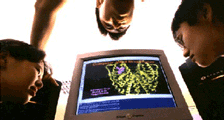



CZ5226: Advanced Bioinformatics
Synopsis
This module is meant
for graduate students with some basic knowledge of bioinformatics without
necessarily requiring them to have general life science background.
The topics covers overview of bioinformatics and its role in biology,
protein sequence alignment methods and applications, databases, molecular
modeling and machine learning methods, software and applications. The
emphasis is on active learning, reading, and mini-projects.
Instructor
Dr. Chen Yu Zong
Department of Computational Science
National University of Singapore
Office: Blk S17 Room 07-24
Tel: 6874-6877. Fax: 6774-6756
E-mail: yzchen@cz3.nus.edu.sg
Web: http://www.cz3.nus.edu.sg/~yzchen
(Lots of info about
biocomputing)
Lectures in 2010/2011:
Lecture 1: Introduction
Lecture 2: Overview of Computer Simulation of Biological Pathways and Network Crosstalk
Lecture 3: Pathway Generation Tool I
Lecture 4: Pathway Generation Tool II
Lecture 5: Pathways in Human Cancer
Lecture 6: Determination of Pathway Parameters
Lecture 7: Biological Network Crosstalk
Lecture 8: Bioinformatics of TCM
Lecture 9: TCM Herbs in Traditionally Defined Properties
Lecture 10: Cheminformatics of TCM
Project in 2010/2011
Lectures in 2009/2010:
Lecture 1: Introduction
Lecture 2: Overview of Computer
Simulation of Biological Pathways and Network Crosstalk
Lecture 3: Pathway Generation Tool
I
Lecture 4: Pathway Generation Tool
II
Lecture 5: Pathways in Human Cancer
Lecture 6: Determination of Pathway
Parameters
Lecture 7: Biological Network
Crosstalk
Lecture 8: Bioinformatics
of TCM
Lecture 9: TCM Herbs
in Traditionally Defined Properties
Lecture 10: Back to the Basics: Python and
Application in Bioinformatics
Projects in 2009/2010:
P01: Signalling pathways with therapeutic significance
Lectures in 2007/2008 & 2008/2009:
Lecture 1: Introduction
Lecture 2: Overview of Computer
Simulation of Biological Pathways and Network Crosstalk
Lecture 3: Pathway Generation Tool
I
Lecture 4: Pathway Generation Tool
II
Lecture 5: Pathways in Human Cancer
Lecture 6: Determination of Pathway
Parameters
Lecture 7: Biological Network
Crosstalk
Lecture 8: Pathway Generation Tool
III
Lecture 9: Back to the Basics: Python and
Application in Bioinformatics
Projects in 2008/2009:
crosstalk_01.xls ............ Group 1
crosstalk_02.xls ............ Group 2
crosstalk_03.xls ............ Group 4
crosstalk_04.xls ............ Group 5
crosstalk_05.xls ............ Group 7
crosstalk_06.xls ............ Group 3
crosstalk_07.xls ............ Group 6
crosstalk_08.xls ............ Group 10
crosstalk_09.xls ............ Group 11
crosstalk_10.xls ............ Group 9
crosstalk_11.xls ............ Group 12
crosstalk_12.xls ............ Group 13
crosstalk_13.xls ............ Group 8
CZ5226 Project Requirements 2009.pdf
CZ5226_Detailed Info_Templet_Example.xls
CZ5226 Name List 2009.doc
Lectures
in 2004/2005:
Lecture 1: Introduction
Lecture 2: Introduction of
immune system I
Lecture 3: Introduction of
immune system II
Lecture 4: MHC molecules
Lecture 5: Motifs and motif prediction methods I
Lecture 6: Motifs and motif prediction methods
II
Lecture 7: Statistical learning methods
Lecture 8: Molecular modelling methods
Lecture 9: Prediction of peptide binders of MHC
Lectures in 2003/2004:
Lecture 1: Introduction
Lecture 2: Sequence alignment methods revisited.
Lecture 3: Discussion on sequence alignment methods
Lecture 4: Applications of sequence alignment methods
Lecture 5: Biological pathways, cellular systems and diseases
Lecture 6: Discussion on biological pathways
Lecture 7: Development of a pathway database
Lecture 8: Fundamentals of molecular modeling
Lecture 9: Molecular dynamics simulations
Lecture 10: Discussion on molecular dynamics simulations
Lecture 11: Molecular dynamics simulation software
MODE
OF ASSESSMENT:
Project 1 (25%); Project 2 (25%); Final (50%)
- Project (2007/2008)
- Project 1: Development of pathway simulation models
- Project 2: Mechanism of biological crosstalks
- Project
(2004/2005)
- Project 1: Bioinformatics of MHC peptide binders
- Project 2: Prediction of MHC peptide binders
- Project (2003/2004)
- Project 1: Use of PSI-BLAST to determine similar proteins of selected therapeutic targets
- Project 2: Biological pathway database development.
References:
Sequence alignment:
- Needleman-Wunsch method: JMB 48, 443-453 (1970)
- PAM: A model of evolutionary change in proteins. In: Atlas of protein sequence and structure (Natl. Biomed. Res. Found. Washington) Vol 5, Suppl 3. pp.345-358 (1978)
- Smith-Waterman method: JMB 147, 195-197 (1981)
- FASTA: Proc. Natl. Acad. Sci. USA 85, 2444 (1988)
- BLAST: JMB 215, 403-410 (1990).
- BLOSUM: Proc. Natl. Acad. Sci. USA 89, 10915-10919 (1992)
- HMM: JMB 235, 1501-153 (1994).
- PSI-BLAST: Nucleic Acids Res. 25, 3389-3402 (1997)
Motifs:
- Methods:
- FASB J. 2002; 16, A543
- Comp. Funct. Gen. 2002; 3, 423
- Bioinformatics 2003; 19, i26
- Structure motifs:
- Nature. 1988 Sep 1;335(6185):45-9.
- Curr Opin Struct Biol. 1996 Jun;6(3):366-76
- MHC peptide motifs:
- Semin Immunol. 1993 Apr;5(2):81-94.
- J Immunol. 1995 Jan 1;154(1):247-59.
Biological pathways:
- Metabolic pathways: Biol. Chem. 381, 899-910 (2000)
- Signaling pathways: Annu. Rev. Cell. Dev. Biol. 15, 269-290 (1999)
- Disease pathways: To be given
- Pathway simulations: Nature Biotech. 18, 768-774 (2000)
Molecular dynamics simulation methods:
- General method
and force field:
- AMBER: J. Am. Chem. Soc. 106, 765-784 (1984); 117, 5179-5197 (1995)
- CHARMM: J. Comp. Chem. 4, 187-217 (1983)
- Steered molecular dynamics simulation: Biophys. J. 73, 2972-2979 (1997); 75, 662-671 (1998)
- Non-bonded Force Fields: J. Phys. Chem. 99, 13019-13027 (1995)
- Atomic partial charges: J. Comp. Chem. 8, 894-905 (1987); 11, 431-439 (1990)
- Hydrogen-bond potentials: J. Quantum Chem. Symp. 1, 49-54 (1974)
- Applications:
- Open "back door" in a molecular dynamics simulation of acetylcholinesterase. Science. 1994 Mar 4;263(5151):1276-8. PMID: 812211
- Binding pathway of retinal to bacterio-opsin: a prediction by molecular dynamics simulations. Biophys J. 1997 Dec;73(6):2972-9. PMID: 941421
- Pathways to a protein folding intermediate observed in a 1-microsecond simulation in aqueous solution. Science. 1998 Oct 23;282(5389):740-4. PMID: 9784131
Free Software
- Tinker (http://dasher.wustl.edu/tinker/)
Solutions to tutorial
Solutions to Lab
 |
|
| about BIDD | databases | software | teaching | research | links | |